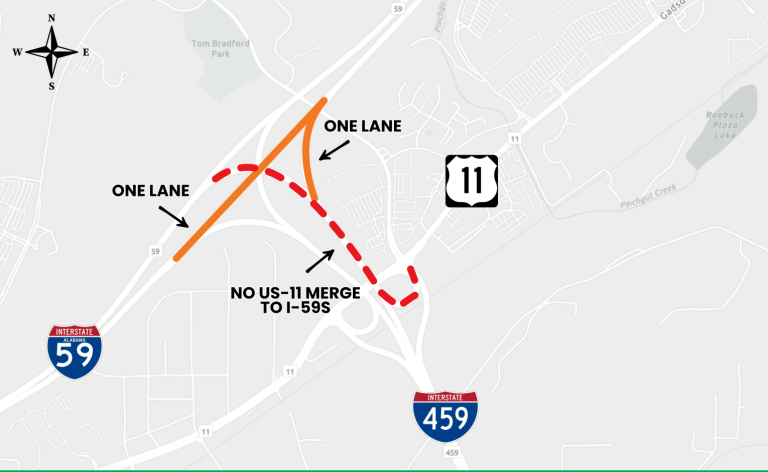Community Foundation of Greater Birmingham calls for regional cooperation
Reading time: 4 minutes

Yesterday, in a presentation to the Rotary Club of Birmingham, the Community Foundation of Greater Birmingham released results of a groundbreaking yearlong research project that highlights opportunities for greater regional cooperation across Jefferson County.
Titled – Together We Can… Charting a Course to Cooperation for Greater Birmingham, the research project, which was conducted by the Public Affairs Research Council of Alabama (PARCA), shows the connection between regional cooperation and a metro area’s prosperity.
Historically, the Birmingham metro area is considered one of the most fragmented in the South, with 35 municipalities in Jefferson County alone.
Job growth – a big difference between cooperative and fragmented metros
For decades, local governmental fragmentation has been seen as a “drag” on Birmingham’s economic growth.
One of the major items in the PARCA report examined the difference in job growth between cooperative metro areas and fragmented metros areas.
According to the report, between 2000-2016, metro areas whose governmental structures foster cooperation experienced explosive job growth, ranging from 20 percent to 50 percent. Cooperative metros listed in the report included Austin, Nashville, Jacksonville, Raleigh, Denver, Charlotte and Oklahoma City.
Fragmented metro areas, such as Birmingham, St. Louis, Cincinnati, Pittsburgh, Cleveland, Detroit and Buffalo experienced job growth ranging from -12 percent to 5 percent growth.
According to PARCA, Birmingham had 0 percent job growth since 2000.

“The results are clear: When there is more cooperation in a metro area, there is more growth in jobs, incomes, and overall prosperity,” said Christopher Nanni, president and CEO of the Community Foundation of Greater Birmingham. “While there are different styles and degrees of cooperation communities benefit when they are able to speak with one voice and unite behind a common purpose or goal.”
Looking at other examples
The report investigates four different approaches to cooperation that have occurred in Pittsburgh, Denver, Louisville and Charlotte. While it examines the pros and cons of each community’s approach, the report does not advocate a particular solution for Birmingham. A critical point made by the report is that local governments can cooperate without giving up their identity and autonomy.
“Cooperation is not the same thing as consolidation,” Nanni said. “Cooperation simply means recognizing that we have a shared fate and working together toward a future that will be more prosperous for all.”

Poll, advisory committee, public discussion and action
Along with the PARCA report, the Community Foundation conducted a poll to explore the views of Jefferson County residents on cooperation. Overwhelmingly, a majority of residents expressed support for greater cooperation to provide services and set regional priorities. Millennials expressed the strongest support for cooperation, but it is important to note that backing for increased cooperation was solid across all respondents regardless of age, gender, race and income level. (Full poll results are available at TogetherWeProsper.org )
The Community Foundation has established an advisory committee and will be working in the coming months to stimulate more public discussion about cooperation. They also hope champions will emerge and consensus on how to foster more cooperation in the Birmingham metro area.
As outlined in Nanni’s presentation to Rotary the Community Foundation will be taking the following steps.
* Community Conversations
* Community Champions
* Consensus on an Approach
* Action
Read the report today and visit the Together We Proper website.
Want to volunteer, set up a presentation and get involved? Send an email to: connect@togetherweprosper.org
Nanni summed up the Community Foundation’s call for cooperation this way.
“We hope this report is a starting point for a community discussion that needs to occur about how the greater Birmingham area can prosper and remain relevant in the future. Ultimately, the final chapter will not be written by the Community Foundation or PARCA but by the people of Jefferson County.”

![Georgia Southern beats App State in JLab Birmingham Bowl [PHOTOS] Georgia Southern beats App State in JLab Birmingham Bowl [PHOTOS]](https://wp.fifu.app/bhamnow.com/aHR0cHM6Ly9iaGFtbm93LmNvbS93cC1jb250ZW50L3VwbG9hZHMvMjAyNS8xMi9iaXJtaW5naGFtYm93bC0zLXNjYWxlZC1lMTc2NzEyMzczMzc0My0xMjAweDYyOC5qcGc/00bfb8674b64/georgia-southern-beats-app-state-in-jlab-birmingham-bowl-photos.webp?w=768&h=0&c=0&p=1579627)

